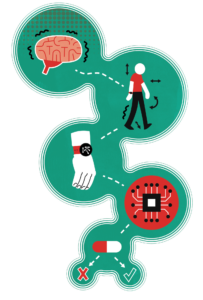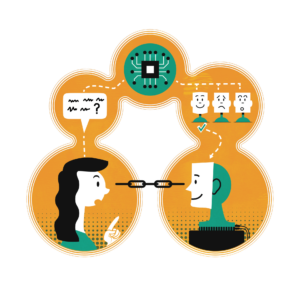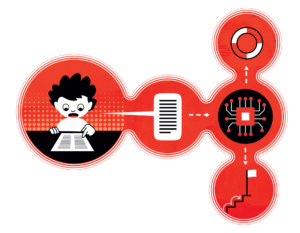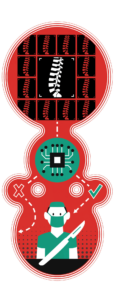Science and AI are converging, as these five studies show
-
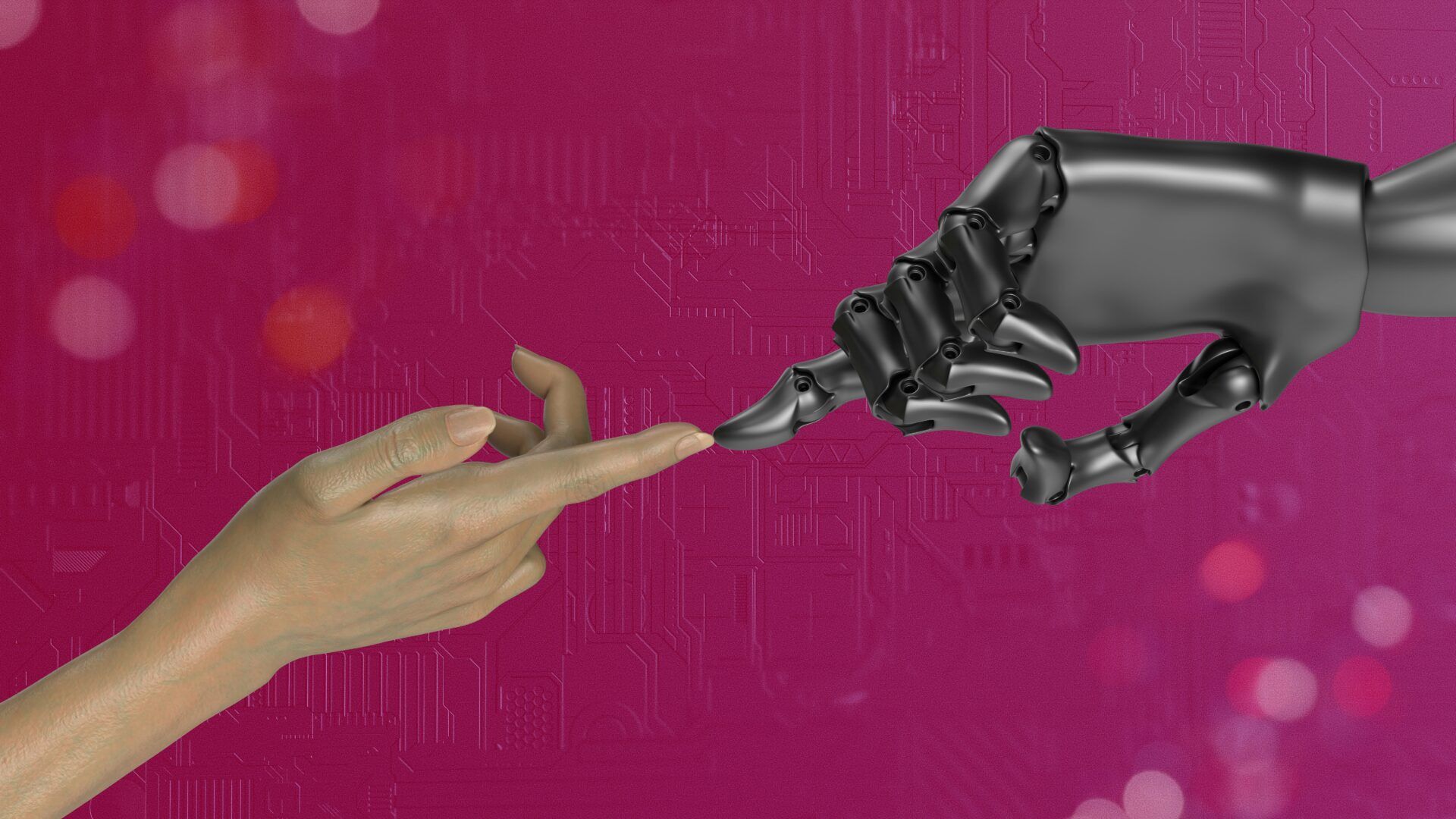 Foto via unsplash
Foto via unsplash
From a smartwatch that maps the progression of Parkinson’s disease to a robot that guides train passengers. Scientists are using AI to come up with solutions to medical and societal problems. Vox highlights five of them.
1. Mapping Parkinson’s Disease with a Smartwatch
With nearly 12 million patients, Parkinson’s is the fastest-growing neurological disease in the world. A complex condition with a multitude of symptoms – ranging from motor decline to cognitive and emotional issues – that increasingly affects younger people. Countless researchers are working on treatments to slow the disease down.
But how do you measure the effectiveness of those treatments? That’s complicated, says researcher Luc Evers of the AI for Parkinson Lab/Radboudumc. ‘Because Parkinson’s often progresses very slowly, it’s difficult to demonstrate the effects of a new therapy based on brief hospital visits where the patient performs tests,’ he explains. ‘Such a visit is just a snapshot. A patient’s performance depends on factors like stress levels at that moment and whether medication was recently taken.’
Sensor Signals
The watch resembles consumer models like those from Garmin or Fitbit. ‘But we use raw sensor signals,’ Evers explains. ‘We measure heart rate and movement at a very high frequency – 100 measurements per second. We then use AI to identify patterns in those signals that specifically relate to Parkinson’s. From that data, we can not only infer activity levels, but also detect tremors, analyze gait patterns, and identify abnormalities.’
‘We measure heart rate at a very high frequency’
The smartwatch may also make a difference in individual treatments. ‘Since symptoms can vary greatly throughout the day, finding an effective medication or exercise schedule is often difficult. If a watch can measure those fluctuations, it becomes easier for a caregiver to tailor treatment to the individual.’
The algorithms developed by Evers and his team to analyze the smartwatch data have recently been made public. ‘This ParaDigMa toolbox enables researchers worldwide to map Parkinson’s symptoms using sensor data from smartwatches.’
That’s why Evers developed a smartwatch that allows researchers to track the progression of the disease over time using digital parameters. In a large-scale study he organized, around 600 people with early-stage Parkinson’s wore such a device day and night for two to three years. That generated a massive amount of data. ‘Because a smartwatch constantly measures heart rate and movement, we hope to gain a much faster and more complete picture of how a new drug works in a home environment.’
2. Calculating Reliable Routes on the Power Grid
With an overcrowded electricity grid, the risk of overload and outages increases. Grid operators must ensure that the system remains reliable. If a power line fails, electricity is rerouted to keep the lights on. But those alternative routes become more heavily loaded, potentially causing new issues. To prevent that, grid operators test in advance whether these routes can handle the extra load. Until recently, this was done with mathematical (computer) calculations checking each rerouting option one by one – a time-consuming task taking hours.
PhD candidate Charlotte Cambier van Nooten investigated on behalf of grid operator Alliander whether AI could speed this up.
New Method
‘Because the grid is so congested, you don’t want it to take hours every time you test small adjustments,’ Cambier van Nooten explains. Using machine learning, she and colleagues developed a new method. ‘Instead of looking at each route individually, this method views the entire network as a whole. In just a few seconds, we can now indicate which alternative routes work well and which don’t – that’s a thousand times faster than before.’ The method is also 5 percent more accurate than traditional techniques.
The researchers trained their model with a wide variety of data, so only minor tweaks are needed for new situations. ‘The power grid in a city like Nijmegen changes frequently – with new homes, businesses, or neighborhoods added. You don’t want to retrain your model each time; that would be very costly,’ says Cambier van Nooten.
‘This method is a thousand times faster’
New methods like this ultimately result in a more reliable electricity supply. ‘Given the current situation with an overcrowded grid, our method makes it possible to fully utilize capacity and test changes in advance. If we leave things as they are, the problems will be even worse in ten years and we may face more frequent outages.’ Grid operator Alliander has already started implementing this new technology.
3. Making a Help Robot More Human
We’re now familiar with chatbots like ChatGPT and DeepSeek. But what if you could have a face-to-face conversation with AI? The Furhat Robot – named after the hat it wore during one of its first presentations – calls itself a ‘social robot.’ During real-time conversations, it makes eye contact, shows facial expressions, and detects emotions from its conversation partner – all using AI.
‘With intense eye contact, people tend to look away more quickly’
Chinmaya Mishra, affiliated with the Max Planck Institute in Nijmegen, researches how to make interactions between Furhat and people more natural.
New Vox
This article is from the new edition of Vox, which is entirely dedicated to AI. In this magazine, you’ll find everything about the impact of artificial intelligence on education, research, and student life. Did you know, for example, that ChatGPT has some pretty interesting ideas for a student-style day in Nijmegen? But not everyone is a fan: three students share why they want nothing to do with AI tools. They’re doing their best — as much as possible — to keep AI out of their daily lives.
One of Mishra’s findings is that people tend to look away more frequently during intense eye contact with the robot.
The Furhat Robot consists of a head on a pedestal with a projected face, which can vary in skin tone, gender, and features. The robot isn’t static – it can nod, shake, and turn its head. A camera built into the base observes the conversation partner’s face.
Delivering Bad News
Multiple AI systems work in parallel to make Furhat function. They analyze facial expressions, convert speech into text, generate fitting expressions and verbal responses.
Furhat can already be seen working as a receptionist at a library in Stockholm and guiding train passengers at Deutsche Bahn. In the Netherlands, Rabobank uses it to train staff for delivering bad news. In the future, Furhat could also be useful in elder care. ‘You can think of it as a conversation partner or as a helper to operate electronic devices.’ Mishra also sees potential in supporting autistic children. ‘Children who struggle with recognizing emotions can practice with Furhat.’
Currently, this is often done using pictures, which is far less realistic, according to the researcher. A robot that can show and recognize human emotions, and hold conversations – should we already fear a robot invasion? Mishra laughs. ‘It’s a running joke here that it’s a good thing Furhat doesn’t have arms or legs.’
4. Developing a Tailored Reading App for Students
If you’re reading this, you already know how to recognize letters and letter combinations and connect them to words and sentences. This is called ‘technical reading’. P-o-n-y is pony and c-a-t is cat. Only when a child can read words quickly and accurately can they focus more on the content of a text.
‘Children’s speech is difficult for AI to analyze’
That’s why early elementary years emphasize this skill. ‘Practicing it is a time-consuming process,’ says Eva van de Sande, co-creation manager at the National Education Lab AI (NOLAI). ‘To assess what children already know, they’re usually asked to read as many words aloud as possible in one minute. It’s nearly impossible for teachers to pinpoint which sounds and words need more practice for each student. Yet targeted instruction can make all the difference.’
In the Technical Reading with ASR (Automatic Speech Recognition) project, NOLAI is working with schools, scientists, and industry to develop a reading app using speech recognition. The app offers personalized exercises for students and insights for teachers on sound and word recognition. ‘With speech technology, you can have children read aloud and then extract information from that recording about what they can or can’t do yet,’ says Van de Sande. ‘A child might struggle with the “au” or “sch” sounds, or with longer words.’
Acoustic Dataset
The resulting data helps teachers quickly see where a child is struggling and what specific exercises they need. Or determine if a student is ahead and needs more of a challenge. Developing the app is no easy feat. ‘Children’s speech is much harder for AI to analyze than adult speech,’ Van de Sande explains. ‘Children often speak faster and at a much higher pitch.’
For this reason, researchers are compiling an acoustic dataset with children’s voices from across the country. This will make the app suitable for a broad range of voices, intonations, and pronunciations.
‘We’re training the app with many different sounds. Take the letter “e”, for example – in a word like reasoning, it sounds slightly different each time. Or take the soft “g” of a child from Limburg.’
The ASR reading app is expected to be available to schools soon and will be tested at various locations.
5. Improving Diagnosis and Treatment Choices for Lower Back Pain
Lower back pain is a common issue, especially among the elderly. But its root cause is often hard to determine. While MRI scans can show various spinal abnormalities, it’s still a challenge for radiologists to determine which one is causing the pain. For his PhD research at Radboudumc, Jasper van der Graaf explored whether AI could help.
‘The technology sometimes performs better than a doctor’
In the first phase, Van der Graaf investigated which MRI features are linked to back pain – such as collapsed or bulging discs. Using 500 scans, he trained AI models to recognize these abnormalities. ‘The AI model had to learn what to look for on the scan,’ the researcher explains. Since no standard software exists for this, he programmed everything himself in Python.
Better Understanding
Van der Graaf’s models can automatically and accurately identify abnormalities such as scoliosis and nerve compression on MRI scans. This helps doctors assess whether surgery is likely to help. ‘Many patients undergo back surgery, but a large number remain dissatisfied. If we can better predict who will benefit – by comparing their profile with that of hundreds of similar patients – we can avoid unnecessary surgeries and offer alternative treatments.’
According to Van der Graaf, AI already analyzes certain cases more accurately than a human doctor. That’s not only useful for clinical decisions, but also for patients. ‘A doctor simply saying, “We’re not going to operate,” can be met with resistance,’ he explains. ‘But if you show that similar patients didn’t benefit from surgery either, people may be more open to other treatments.’ Not all doctors are convinced of AI’s potential, he adds. ‘But it’s now been proven that in some diagnoses, the technology performs just as well – or better – than a physician’s assessment.’
Van der Graaf’s AI model has yet to be integrated into hospital treatment protocols. ‘A new PhD candidate will need to continue the research and further refine the algorithms – but funding is needed first.’
